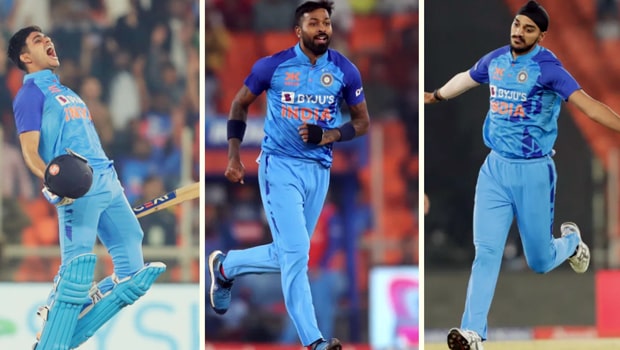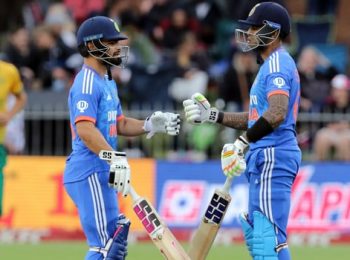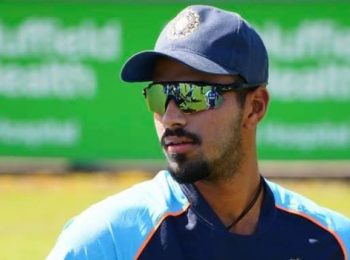After winning seven consecutive white-ball matches at home in the span of a few weeks, the Indian cricket team was jolted by New Zealand in the first T20I but rebounded to level the series in the second match to deny the opposition their first T20I series win on Indian soil since 2012. Then, in the decider, the home team rose to the occasion to smash New Zealand by a whopping 168 runs and take the series 2-1.
This win extended India’s dominance home T20I record – in the past decade, only Australia in 2019 and South Africa in 2015 have won series here – and underlined their No 1 status, despite Rohit Sharma, Virat Kohli, KL Rahul and Axar Patel being rested.
PITCHES COP CRITICISM AFTER SPIN DOMINATES
The pitches for the first two T20Is, at Ranchi and Lucknow respectively, came in for widespread criticism given the amount of assistance for spinners on both sides – the ball spat up and turned sharply at both venues, where run-scoring proved difficult – and because it was felt that the spectators were not provided with quality entertainment. In the first match at Ranchi, India were chasing 177 and ended up with 155 for 9, after which India’s captain Hardik Pandya and his opposite number Mitchell Santner both expressed surprise at the amount of spin the JSCA Stadium provided New Zealand’s spinners in the second half.
In both T20Is, the captains resorted to bowling spin upfront before the dew could set in and the results were quick and devastating. Chasing 177, India slipped to 33/3 inside the Powerplay overs while losing wickets to Santner and Michael Bracewell. In the second match, Pandya started the match himself but thereon he used four spinners in succession and did not use Arshdeep Singh and Shivam Mavi, the two specialist pacers chosen in the XI, until the 17th over by which stage New Zealand were 80/6. When India batted, New Zealand used five spinners and at one stage Santner asked his pace tearaway Lockie Ferguson if he’d be up for resorting to bowling some offspin. India won that match with one delivery left, chasing a target of 100 with six wickets in hand. Suryakumar Yadav, the top-ranked T20I batsman known for his sub-200 strike-rate innings, was adjudged Man of the Match for scoring 26* off 31 deliveries.
Some 48 hours later, the curator at Lucknow’s Ekana Stadium found himself without a job after he and his crew rolled out a pitch that Pandya termed “a shocker” following a low-scoring game in which the spinners bowled 30 out of the 39.5 overs that were bowled and not a single six was hit.
While Pandya, as well as Gautam Gambhir, Jimmy Neesham and Wasim Jaffer on respective cricket shows as experts, were all critical of the Ranchi and Lucknow surfaces, the likes of Santner, Bracewell and India’s Washington Sundar did point to the test of skill required from the batsmen as well as the chance for spinners to get into the game following a diet of high-scoring ODI matches.
HAS GILL SEALED ALL-FORMAT STATUS?
When the ball dominates the bat in such a manner, you expect a few batsmen to have struggled. One such was Shubman Gill, who after reeling off three centuries in four ODIs came a cropper in the first two T20Is against New Zealand, undone by a ball from Santner that stopped on him in Ranchi and then finding deep square leg, on 11, in the second match. On those turning tracks he was found wanting, but on a true batting surface in the Ahmedabad decider, Gill cracked his way to a maiden hundred in T20Is. This was, in fact, the first time he had reached 50 in the format.
To cast aside two low scores and smash your way to a hundred off just 54 balls was a big statement from Gill. His place in the T20I side has been questioned, including by this writer, when the likes of Ruturaj Gaikwad and Sanju Samson have been overlooked. But perhaps it was a matter of time before Gill, 23, repaid the faith in the shortest format. Since he scored his maiden Test century in December, Gill has been in top form with 567 runs in six ODIs this year. This run of dominance includes scores of 70, 116, 208 and 112 and so, despite failures in Ranchi and Lucknow, it was not entirely out of everyone’s belief that Gill could deliver on a truer surface.
His 126* off 63 balls featured 12 fours and seven sixes, and like during his maiden ODI double-hundred recently, his shots were not slogs or brute force. This was a special innings underlined by sublime timing and effortless pick-up shots off the pads, even if Gill was given a life on 33. In the form of his international career, he is a lock-in for ODIs and Tests, though he might have to bat in the middle order during the upcoming Border-Gavaskar Trophy. As for T20Is, with KL Rahul struggling and Ishan Kishan unable to make use of his opportunities in these three matches, the question must be considered: Has Gill done enough to hold down his spot?
ARSHDEEP IS BACK
From the high of being arguably the breakout bowler for India in 2022 – he was the team’s leading wicket-taker with 33 at 18.12 apiece from 21 T20Is last year – the left-arm quick Arshdeep Singh’s aura had faded somewhat before this series. Though his final T20I of 2022 saw him take 4/37 against New Zealand in Napier, doubts increased after he bowled five no-balls in a match versus Sri Lanka from which he conceded 37 runs in 12 balls without a wicket.
He hit back with 3/20 in the very next T20I, but questions were being asked about Arshdeep’s future. Harshly, yes, but after he gave 27 runs in one over during the first match with New Zealand the knives were out again. Having the team management’s faith in what is the toughest job in T20Is, arguably, the 23-year-old put in two successive performances that showed why he is one for the long haul.
On that turning Lucknow track, Arshdeep was not called on until the 18th over and terrifically to claim 2/7 in two overs. Then in the decider, he rocked New Zealand upfront with identical figures from his first two overs as the chasing team crashed to 21/5.
The accuracy and slight movement was back, as was Arshdeep’s ability to nail the ball in the blockhole during the slog overs. A series-leading haul of five wickets at 14.80 apiece, and an economy of 8.22, shows that he remains a vital cog in the wheel with one eye on the 2024 T20 World Cup.



























